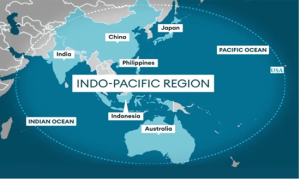With tensions between China and India intensifying, there will be significant changes and challenges in the Indian Ocean and South Asian regions.
Significance of Indo-Pacific region
- Trade and Economical Factors: The Indo-Pacific Region makes up 65% of the global population, occupies 44% of the planet’s surface area, generates 62% of global GDP, and supports 46% of global trade in goods.
- Non- Traditional Threats: Due to its size, the area faces a variety of risks that are challenging to identify and manage, including piracy, illegal fishing, human trafficking, terrorism, and environmental dangers.
- Vast Natural Resources: The immense quantities of marine resources found in the Indian and Pacific Oceans together include offshore hydrocarbons, methane hydrates, sea bed minerals, rare earth metals, fisheries, etc.
- Historical importance: The Indian Ocean has been one of the most important Sea Lane of Communication (SLOCs) for trade due to the faster development in the region since ancient times.
Challenges:
- Chinese Influence: South Asian countries are hesitant to completely move away from China as they hope to exercise their agency by balancing with China and India. And this trend will only increase with new players entering the region.
- Economic and Political Turmoil in Region: Nepal, the Maldives and Bhutan are struggling with depleting forex reserves. Bangladesh has reached a bailout agreement worth $4.5 billion with the International Monetary Fund.
- Inflation and Slow economic growth: Energy shortages, inflation, and negative or slow economic growth are also disrupting day-to-day activities in these countries.
The COVID-19 pandemic and Russia’s invasion of Ukraine have continued to haunt the region with rising inflation, affecting the economies.
- Different Capacities & Capabilities: The region is highly heterogeneous in terms of economic size and level of development, with significant differences in security establishments and resources.
- There exists a political rhetoric describing the I.P as an arc of prosperity where everyone can work together. While political focus is centred on such opportunities, it often detracts from the real issues such as countering the Chinese assertion.
- Chinese policy is popular for uncertainty and swinging from one extreme to anotherswiftly, as evident from their slogan “Let a hundred flowers bloom” followed by a cultural revolution. In 2012, Scarborough shoal in the South China Sea was invaded and barricaded by China.
Steps taken by India:
•In Maldives – New Delhi is reciprocating President Ibrahim Solih’s ‘India First’ policy with massive economic assistance, grants, and infrastructure projects and by also cooperating on maritime security.
•In Nepal – Prime Minister Deuba’s government has attempted to improve Nepal’s overall bilateral relations with India.
•In Sri Lanka – In 2022, India has provided economic and humanitarian assistance and investments worth 4 billion dollars.
•Steps by Quad members – Quad members include Japan, Australia, and the United States. Close cooperation among these partners has ensued to offer genuine alternatives to the BRI such as assistance to Sri Lanka.
• In Maldives, Australia and the U.S. have committed to opening their embassies and new areas of cooperation.
• In 2020, the U.S. signed a defence and security framework with the Maldives.
Way ahead
- Addressing China’s adventurism holistically: There needs to be a unified strategy and a common agenda to contain Chinese expansionist strategy in the Indo-pacific region.
- Capturing the Opportunity: India to balance out Chinese hegemony in the region.
For e.g., smaller nations of South Asia, as well as, South East Asia are looking to counter Chinese influence by strengthening their own ties with India.
- Upgrading the Indian navy to a blue-water navy:With China’s increased assertiveness in the Indian Ocean and a scramble for bases (even Russia has acquired a base in Sudan recently), India needs to realise the inherent importance of the Indian Ocean region.
- It is time to shed historical hesitation in allowing other like-minded nations to have deployments in the Indian Ocean Region: The flaw in the Indian foreign policy is that it is not letting its friend’s aid itself in the Indian Ocean region as they are sensitive to Indian concerns, while at the same time, it is unable to stop its adversaries from dominating the region.
- Net security Provider: India has traditionally been the power upon which small countries in the Indian Ocean Region have depended. For e.g. the Indian navy supplied fresh water to the Maldives when its Reverse Osmosis plant failed.
- Peaceful resolution of disputes: India has believed in resolving the disputes in a friendly manner as is manifested in its complete acceptance of the Permanent Court of Arbitration’s award in favour of Bangladesh in the Indo-Bangladesh marine boundary arbitration.
Indo Pacific (I.P) is interpreted differently by different countries. There are mainly three versions to the interpretation:
- The Indian version views I.P as an inclusive space for all stakeholders based on common responsibilities and common interests.
- US version interprets a free and open I.P based on a rules based order.
- It is little different from the Indian version in such a way that it excludes any country which doesn’t abide by certain rules and expected norms of conduct.
- Further, the US version of I.P extends from the Pacific shores of America to the Bay of Bengal only, while the Indian version includes the area up to the shores of Eastern Africa.
- A third version is one which is interpreted by ASEAN, as a model based on consociation, unlike the rules based order prescribed by the US and to some extent by India as well.
- Consociation refers to a political system formed by the cooperation of different and opposing social groups on the basis of power sharing.
They argue for practical cooperation with China instead of merely treating it as any other stakeholder.

